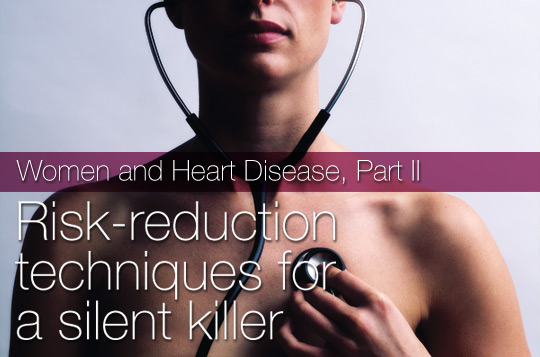
BY KASHMIRA P. BHADHA, MD, FACC
 |
|
Coronary heart disease (CHD) is the leading cause of death in women, and more women die from it each year than men. The Centers for Disease Control and Prevention attributes 38 percent of deaths in women to CHD, compared with 22 percent to cancer.
Back in issue two of Heartlines, the differences in coronary heart disease (CHD) symptoms between men and women as well as conditions that increase the risk of CHD in women were discussed in the “An Equal Opportunity Killer” article. As a follow up, this article discusses diagnostic testing, treatment options, and risk-reduction techniques for CHD.
Diagnostic tests: Diagnostic testing should include a stress echocardiogram or nuclear stress test with myocardial perfusion scans, coronary computed tomography (CT) angiogram, or cardiac catheterization. These tests are popularly referred to as stress tests, CT scans, and cardiac caths. But a simple stress test alone is often not sufficient for women. A regular stress test (using electrocardiograms at rest and during exercise) carries a low sensitivity and specificity, which is why it is not the preferred form of stress testing in women.
Treatment: In general, CHD treatment is the same for men and women. However the benefits of aspirin in primary and secondary prevention of CHD have not been proven in women. Medications such as beta blockers (Lopressor, Tenormin, etc.), angiotensin-converting enzyme (ACE) inhibitors (Altace, Lisinopril), and lipid lowering agents, also known as statins (Lipitor, Zocor), are equally beneficial for men and women.
Percutaneous transluminal coronary angioplasty (PTCA): Women undergoing catheter-based revascularization (angioplasty) are typically older with more risk factors than the men who receive this procedure. They also consequently suffer more complications and have poorer results. Initial angiographic success rates are similar for men and women, but women are more likely to experience vascular complications (such as abrupt closure of the artery or groin complications), emergency bypass surgery, and death. But for the long term, restenosis rates (reclosure of the stent) are fairly similar in men and women.
Coronary artery bypass grafting (CABG): Women face increased long-term and short-term risk of complications and a higher death rate than men after the procedure. This is because women who undergo bypass surgery are typically older and sicker than men. Women also have a greater likelihood of procedural complications, such as heart failure, perioperative infarction, and hemorrhage, as well as death. Death rates in women one month after surgery are more than double that in men — the 30-day mortality is 7 percent in women vs. 2.8 percent in men. A series involving more than 2,100 patients noted higher mortality in women even up to two years after the procedure. High short-term mortality in women was attributed to patient-related factors such as age, coronary risk factors, small body size, and smaller coronary artery size.
Often, patients may not exhibit classic symptoms of CHD. To rule out CHD in this group, newer tests have been developed and may be indicated.
Coronary artery calcium screening
Measurement of coronary calcium using cardiac CT and expressed as an Agatston or volumetric score is an effective way to gauge cardiovascular disease risk and provide information that can complement the Framingham risk score (FRS). FRS defines the risk of developing CHD during a span of 10 years.
Calcium scores can aid decision making regarding drug treatment and whether more aggressive lifestyle changes are needed. A coronary calcium score of 400 or more indicates a severe atherosclerotic plaque burden. A score of 100 to 309 denotes a moderate coronary
plaque burden.
This screening procedure is particularly useful for women between the ages of 50 and 70 who have an FRS of 5 to 10 percent — especially those with a family history of coronary disease — because in these patients with borderline risk, it is unclear whether they should be treated with lifelong aspirin and statin therapy.
Very few women 65 years of age and younger have enough risk factors to produce an FRS greater than 10 percent. Some of these women, however, especially those with a family history of premature coronary heart disease and components of metabolic syndrome, have relatively high levels of coronary calcium and could benefit from knowing their score in order to start more aggressive lifestyle changes and consider a regimen of aspirin and a statin.
Measuring C-reactive protein levels
C-reactive protein (CRP) is a marker of inflammation; inflammation in blood vessel walls may lead to CHD. The Reynolds Risk Score adds the CRP to the FRS equation to estimate the 10-year risk of cardiac death or myocardial infarction with improved predictability in women compared to the FRS alone. However, in middle-aged people, calcium scores seem to be more reliable for predicting future coronary disease events than do serum levels of hs-CRP.
Measuring carotid artery thickness
Atherosclerotic deposits in the carotid artery can be determined by an ultrasound examination of carotid intimal-medial thickness (thicknesses of the inner and middle layer of the carotid artery wall).
Note: Calcium scores are easier to measure in a reproducible way than carotid intimal-medial thickness, which depends more on the skill of the person taking the measurement.
Testing of endothelial function
Testing can be done either invasively (by injecting acetylcholine into the coronary or brachial arteries) or noninvasively (by brachial artery reactivity testing).
The good news is that since 2003, female heart disease awareness has increased. The American Heart Association’s Go Red for Women Awareness campaign, WomenHeart’s Red Bag of Courage plastic tote bags, red silicone bracelet, talk shows, and major media coverage have all helped inform the public of women’s risk of heart disease.


